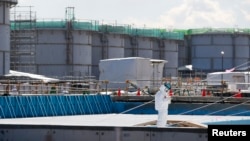The operator of Japan’s damaged Fukushima nuclear plant admitted Thursday that in 2011 it failed for two months to announce that meltdowns had occurred in the cores of three reactors.
Tokyo Electric Power Company (TEPCO) said its officials had no knowledge of a company emergency manual that described a meltdown as damage exceeding five percent of a reactor’s fuel.
Despite early damage estimates of 25 to 55 percent, TEPCO described the state of the reactors only as “core damage” for two months following a massive earthquake and tsunami that hit the nuclear plant in March 2011.
Noting that the company’s initial wording may have been misleading, TEPCO spokesman Shinichi Nakakuki said the language had no effect on the company's response to the emergency, which was to “cool the cores no matter what.”
The Nuclear and Industrial Safety Agency was also reluctant to use the term “meltdown” to describe the incident; a former spokesman was removed for suggesting one day after the disaster that a “meltdown of the reactor’s core” may have been taking place.
Accused of softening its language to cover up the serious extent of the damages, TEPCO claimed that the estimated damage percentage was immediately reported to the government, as is required under Japanese law.
In 2012, TEPCO reportedly admitted that it had underplayed safety risks at the Fukushima plant for fear of triggering public angst and fueling anti-nuclear movements as well as prompting additional measures that could lead to a plant shutdown.
TEPCO finally adopted the term “meltdown” in May 2011 after a computer simulation indicated that one reactor’s fuel was almost entirely melted, and the cores of two other reactors had melted significantly.
The power company said it discovered the emergency manual this month. Officials have promised an investigation into why it was overlooked at the time of the disaster at Fukushima.







